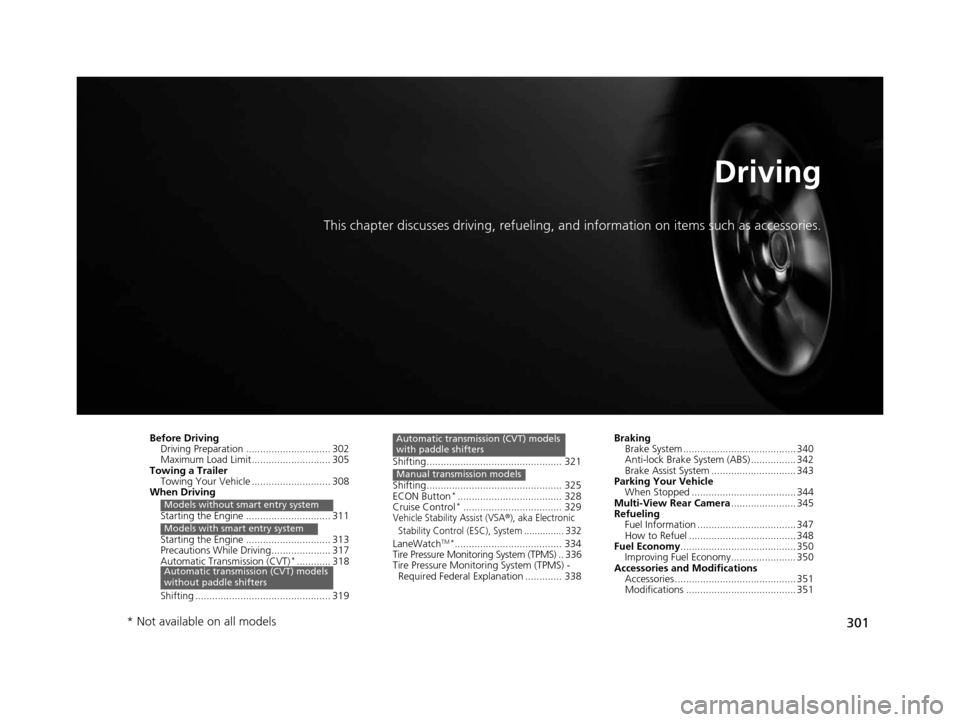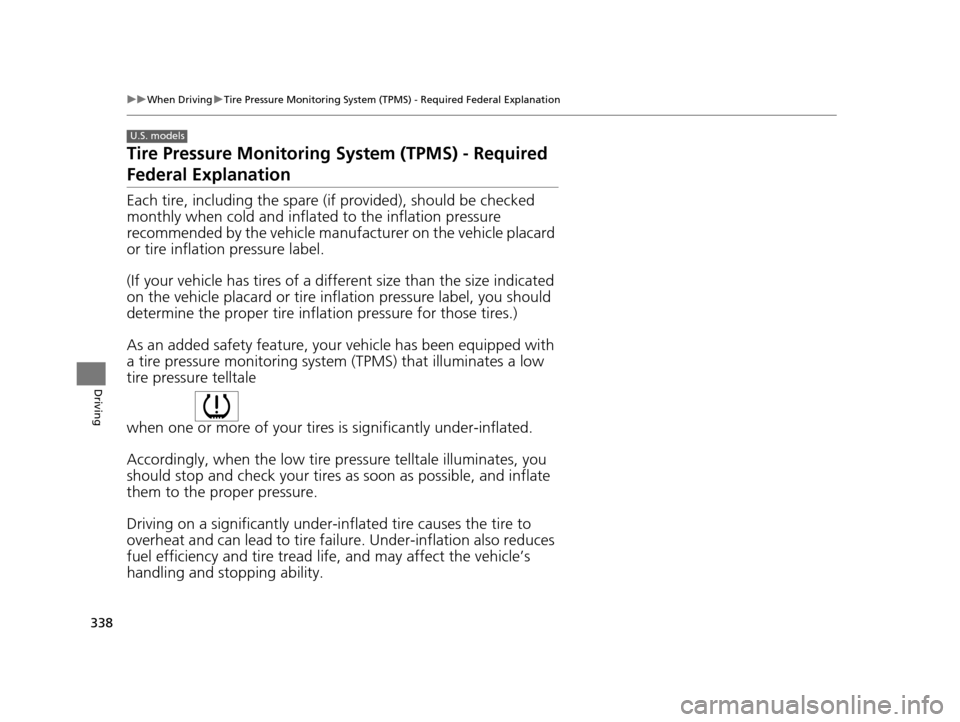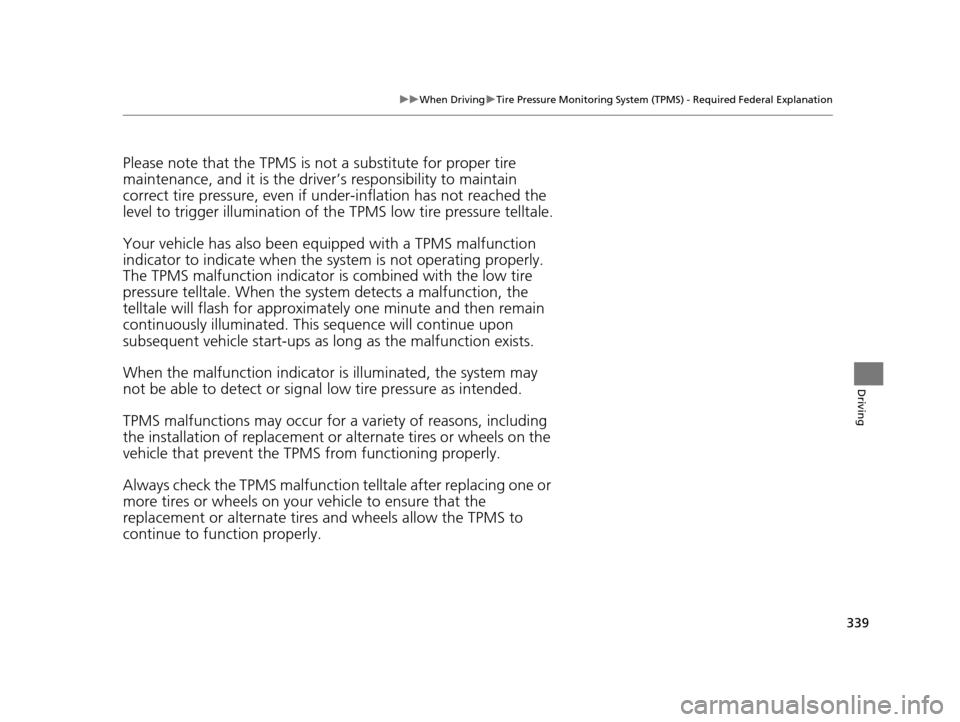2015 HONDA FIT pressure monitor
[x] Cancel search: pressure monitorPage 5 of 453

4
Quick Reference Guide
Quick Reference Guide
Visual Index
*1 : Models with the smart entry system have an ENGINE START/STOP button instead of an ignition switch.
❙Tire Pressure Monitoring System (TPMS) Button* (P337)
❙ENGINE START/STOP Button*1 (P117)
❙Steering Wheel Adjustments (P130)
❙Heating and Cooling System*
(P154)
❙Climate Control System* (P157)
❙Rear Window Defogger (P129)
❙Heated Mirror Button* (P129)
❙Audio/Information Screen (P171, 192)
❙Audio System (P162)
❙Navigation System*
() See the Navigation System Manual
❙Hazard Warning Button
❙System Indicators (P70)
❙Gauges (P82)
❙Information Display (P83)
❙ECON Button* (P328)
❙ (Vehicle Stability Assist (VSA ®) System OFF) Button (P333)
❙Ignition Switch* (P116)
15 US FIT-31T5A6000.book 4 ページ 2014年3月6日 木曜日 午後7時5分
Page 22 of 453

21
Quick Reference Guide
VSA® OFF Button (P333)
● The vehicle stability assist (VSA ®) system
helps stabilize the vehicle during
cornering, and helps maintain traction
while accelerating on loose or slippery
road surfaces.
● VSA ® comes on automatically every time
you start the engine.
● To turn VSA ® on or off, press and hold
the button until you hear a beep.
Cruise Control* (P329)
● Cruise control allows you to maintain a
set speed without keeping your foot on
the accelerator pedal.
● To use cruise control, press the CRUISE
button, then press the -/ SET button once
you have achieved the desired speed
(above 25 mph or 40 km/h).
Tire Pressure Monitoring
System (TPMS)
(P336)
● Detects a change in tire conditions and
overall dimensions due to decrease in tire
pressures.
● TPMS is turned on automatically every
time you start the engine.
● A calibration procedure must be
performed when certain conditions arise.
U.S. models only
Refueling (P347)
Fuel recommendation: Unleaded gasoline with a pump octane number 87 or
higher required
Fuel tank capacity: 10.6 US gal (40 L)
aPull the fuel fill door
release handle.
bTurn the fuel fill cap
slowly to remove the
cap.
cPlace the cap in the
holder on the fuel fill
door.
dAfter refueling, screw
the cap back on until it
clicks at least once.
* Not available on all models
15 US FIT-31T5A6000.book 21 ページ 2014年3月6日 木曜日 午後7時5分
Page 302 of 453

301
Driving
This chapter discusses driving, refueling, and information on items such as accessories.
Before Driving
Driving Preparation .............................. 302
Maximum Load Limit............................ 305
Towing a Trailer Towing Your Vehicle ............................ 308
When Driving
Starting the Engine .............................. 311
Starting the Engine .............................. 313
Precautions While Driving..................... 317
Automatic Transmission (CVT)
*............ 318
Shifting ................................................ 319
Models without smart entry system
Models with smart entry system
Automatic transmission (CVT) models
without paddle shifters
Shifting................................................ 321
Shifting................................................ 325
ECON Button
*..................................... 328
Cruise Control*................................... 329Vehicle Stability Assist (VSA®), aka Electronic
Stability Control (ESC), System ............... 332
LaneWatchTM*...................................... 334
Tire Pressure Monitoring System (TPMS) .. 336
Tire Pressure Monitoring System (TPMS) -
Required Federal Explanation ............. 338
Automatic transmission (CVT) models
with paddle shifters
Manual transmission models
Braking Brake System ........................................ 340
Anti-lock Brake System (ABS) ................ 342
Brake Assist System .............................. 343
Parking Your Vehicle When Stopped ..................................... 344
Multi-View Rear Camera ....................... 345
Refueling Fuel Information ................................... 347
How to Refuel ...................................... 348
Fuel Economy ......................................... 350
Improving Fuel Economy....................... 350
Accessories and Modifications Accessories ........................................... 351
Modifications ....................................... 351
* Not available on all models
15 US FIT-31T5A6000.book 301 ページ 2014年3月6日 木曜日 午後7時5分
Page 337 of 453

336
uuWhen Driving uTire Pressure Monitoring System (TPMS)
Driving
Tire Pressure Monitoring System (TPMS)
Instead of directly measuring the pressu re in each tire, the TPMS on this vehicle
monitors and compares the rolling radius and rotational characteristics of each
wheel and tire while you are driving to determine if one or more tires are
significantly under-inflated. This will caus e the low tire pressure/TPMS indicator to
come on.
You must start TPMS calibration every time you:
• Adjust the pressure in one or more tires.
• Rotate the tires.
• Replace one or more tires.
Before calibrating the TPMS:
• Set the cold tire pressu re in all four tires.
2Checking Tires P. 384
Make sure:
• The vehicle is at a complete stop.
• The shift lever is in
(N.
• The shift lever is in
(P.
• The ignition switch is in ON
(w*1.
*1 : Models with the smart entry system have an ENGINE START/STOP button instead of an ignition switch.
■TPMS Calibration
U.S. models only
1Tire Pressure Monitoring System (TPMS)
The system does not monitor the tires when driving
at low speed.
Conditions such as low ambient temperature and
altitude change directly a ffect tire pressure and can
trigger the low tire pressure/TPMS indicator to come on.
Tire pressure checked and inflated in:
•Warm weather can beco me under-inflated in
colder weather.
•Cold weather can become over-inflated in warmer
weather.
The low tire pressure/TPMS indicator will not come
on as a result of over inflation.
The TPMS may not function pr operly if tire type and
size are mixed. Make sure to use the same size and
type of tire. 2 Checking and Maintaining Tires P. 384
The low tire pressure/TPMS indicator may come on
with a delay or may not come on at all when:
•You rapidly accelerate, decelerate, or turn the
steering wheel.
•You drive on snowy or slippery roads.
•Snow chains are used.
The low tire pressure/TPMS indicator may come on
under the following conditions:
•A compact spare tire is used.•There is a heavier and uneve n load on the tires than
the condition at calibration.
•Snow chains are used.
Manual transmission models
Automatic transmission (CVT) models
All models
15 US FIT-31T5A6000.book 336 ページ 2014年3月6日 木曜日 午後7時5分
Page 338 of 453

337
uuWhen Driving uTire Pressure Monitoring System (TPMS)
Driving
Press and hold the TPM S button until the low
tire pressure/TPMS indicator blinks twice,
indicating the calibration process has begun.
• If the low tire pressure/TPMS indicator does
not blink, confirm the above conditions
then press and hold the TPMS button again.
• The calibration process finishes
automatically.
*1 : Models with the smart entry system have an ENGINE START/STOP button instead of an ignition switch.
1TPMS Calibration
•TPMS cannot be calibrated if a compact spare tire is
installed.
•The calibration process requires approximately 30
minutes of cumulative dr iving at speeds between
30-60 mph (48-97 km/h).
•During this period, if the ignition is turned on*1 and
the vehicle is not move d within 45 seconds, you
may notice the low tire pressure/TPMS indicator
comes on briefly. This is normal and indicates that
the calibration process is not yet complete.
If the snow chains are installed, remove them before
calibrating the TPMS.
If the low tire pressure/TPMS indicator comes on even
when the properly inflated specified regular tires are
installed, have your vehicle checked by a dealer.
We recommend that the tires be replaced with the
same brand, model, and size as the originals. Ask a
dealer for details.
TPMS Button
Low Tire Pressure/TPMS Indicator
15 US FIT-31T5A6000.book 337 ページ 2014年3月6日 木曜日 午後7時5分
Page 339 of 453

338
uuWhen Driving uTire Pressure Monitoring System (TPMS) - Required Federal Explanation
Driving
Tire Pressure Monitoring System (TPMS) - Required
Federal Explanation
Each tire, including the spare (i f provided), should be checked
monthly when cold and inflated to the inflation pressure
recommended by the vehicle manufacturer on the vehicle placard
or tire inflation pressure label.
(If your vehicle has tires of a different size than the size indicated
on the vehicle placard or tire infl ation pressure label, you should
determine the proper tire inflat ion pressure for those tires.)
As an added safety feature, your vehicle has been equipped with
a tire pressure monitoring system (TPMS) that illuminates a low
tire pressure telltale
when one or more of your tire s is significantly under-inflated.
Accordingly, when the low tire pr essure telltale illuminates, you
should stop and check your tires as soon as possible, and inflate
them to the proper pressure.
Driving on a significantly under-in flated tire causes the tire to
overheat and can lead to tire fail ure. Under-inflation also reduces
fuel efficiency and tire tread li fe, and may affect the vehicle’s
handling and stopping ability.
U.S. models
15 US FIT-31T5A6000.book 338 ページ 2014年3月6日 木曜日 午後7時5分
Page 340 of 453

339
uuWhen Driving uTire Pressure Monitoring System (TPMS) - Required Federal Explanation
Driving
Please note that the TPMS is not a substitute for proper tire
maintenance, and it is the driver ’s responsibility to maintain
correct tire pressure, even if un der-inflation has not reached the
level to trigger illumination of th e TPMS low tire pressure telltale.
Your vehicle has also been equi pped with a TPMS malfunction
indicator to indicate when the system is not operating properly.
The TPMS malfunction indicator is combined with the low tire
pressure telltale. When the syst em detects a malfunction, the
telltale will flash fo r approximately one minute and then remain
continuously illumina ted. This sequence will continue upon
subsequent vehicle start-ups as long as the malfunction exists.
When the malfunction indicator is illuminated, the system may
not be able to detect or signal low tire pressure as intended.
TPMS malfunctions may occur for a variety of reasons, including
the installation of replacement or alternate tires or wheels on the
vehicle that prevent the TPMS from functioning properly.
Always check the TPMS malfunction telltale after replacing one or
more tires or wheels on your vehicle to ensure that the
replacement or alternate tires and wheels allow the TPMS to
continue to function properly.
15 US FIT-31T5A6000.book 339 ページ 2014年3月6日 木曜日 午後7時5分
Page 452 of 453

451
Index
Setting the Clock........................................ 88
Shift Lever .......................... 20, 319, 321, 325
Shift Position Indicator .............. 72, 320, 322
Shifting (Transmission) ............ 319, 321, 325
Shoulder Anchor ........................................ 37
Side Airbags ............................................... 48
Side Curtain Airbags .................................. 50
Siri Eyes Free ............................................. 218
Snow Tires ................................................ 392
Spare Tire ......................................... 405, 433
Spark Plugs ............................................... 432
Specifications ........................................... 432
Specified Fuel ................................... 347, 432
Speedometer .............................................. 82
SRS Airbags (Airbags) ................................ 44
Starter System Indicator ............................ 77
Starting the Engine .......................... 311, 313
Does Not Start ........................................ 411
Engine Switch Buzzer .............................. 116
Jump Starting ......................................... 414
Steering Wheel ........................................ 130
Adjusting ................................................ 130
Stopping ................................................... 344
Summer Tires ............................................ 392
Supplemental Restraint System (SRS) ....... 44
Switches (Around the Steering Wheel) ........ 4, 5, 116T
Tachometer................................................. 82
Tailgate ..................................................... 107
Temperature High Temperature Indicator ....................... 74
Low Temperature Indicator ........................ 74
Tie-down Hooks ........................................ 151
Time (Setting) ............................................. 88
Tire Pressure Monitoring System (TPMS) ..................................................... 336
Indicator .................................................... 76
Tires ........................................................... 384
Air Pressure ..................................... 385, 433
Checking and Maintaining ....................... 384
Inspection ................................................ 384
Labeling .................................................. 385
Puncture (Flat Tire) ................................... 405
Regulations ............................................. 387
Rotation .................................................. 391
Spare Tire ........................................ 405, 433
Summer .................................................. 392
Tire Chains .............................................. 392
Wear Indicators ....................................... 389
Winter ..................................................... 392
Tools .......................................................... 404
Towing a Trailer ....................................... 307
Towing Your Vehicle Emergency .............................................. 428 TPMS
(Tire Pressure Monitoring System) ........ 336
Indicator.................................................... 76
Transmission ............................. 319, 321, 325
7-Speed Manual Shift Mode .................... 323
Automatic ............................................... 318
Fluid ........................................................ 370
Manual ................................................... 325
Number................................................... 434
Shift Position Indicator............... 72, 320, 322
Trip Meter ................................................... 84
Troubleshooting ....................................... 403
Blown Fuse...................................... 423, 425
Brake Pedal Vibrates .................................. 24
Buzzer Sounds When Opening Door.......... 25
Emergency Towing .................................. 428
Engine Won’t Start .................................. 411
Noise When Braking .................................. 25
Overheating ............................................ 417
Puncture/Flat Tire .................................... 405
Rear Door Won’t Open...................... 25, 102
Select Lever Won’t Move ......................... 416
Warning Indicators .................................... 70
Turn Signals .............................................. 121
Indicators (Instrument Panel) ..................... 77
15 US FIT-31T5A6000.book 451 ページ 2014年3月6日 木曜日 午後7時5分